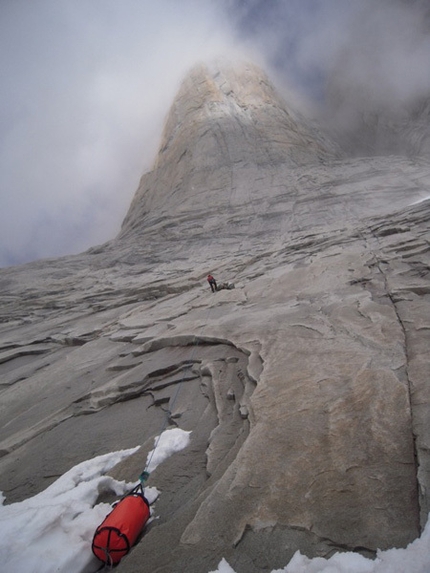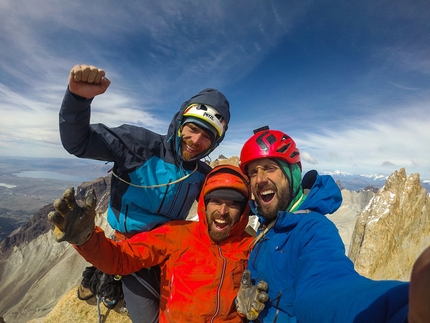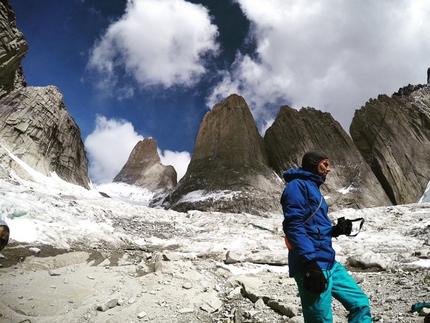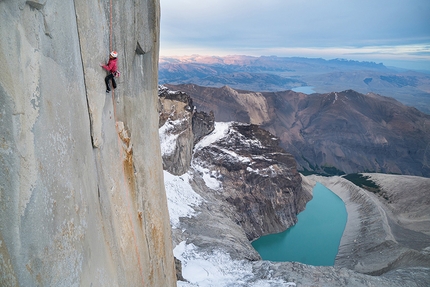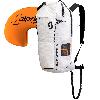Cuerno Este of Cuernos del Paine in Patagonia climbed by Jurado, Marcotti, Pelletti

 1 / 17
1 / 17 Sebastian Pelletti archive
Sebastian Pelletti archive
One of the most emblematic mountains in Chile’s Torres del Paine National Park, actually in all of Patagonia for that matter, has somewhat incredibly been climbed for the first time only now, at the hands of a young international team comprised of Pepo Jurado from Ecuador, Romano Marcotti from Chile and Sebastian Pelletti from Australia. On the 19th of January 2022 the trio made the first ascent of Cuerno Este, the striking right-hand peak as viewed from across Lake Pehoé; the new route is called Vacaciones Metamórficas and checks in 5.11-. The only gear left in-situ was a piton, a stopper and a bunch of natural anchors used for the abseil down the north ridge. Pelletti provides the details about this remarkable ascent.
Seb congratulations for this amazing first ascent! Before telling us about the climb, can you give us some background information about yourselves?
Thanks! The team was made up of Romano Marcotti (Chilean climber and rock climbing guide) Pepo Jurado (Ecuadorian climber and mountain guide) and myself (Australian climber / mountain guide). We have all been lucky to make ascents of the four Towers of Paine in the past.
You made a first attempt with Romano a few weeks ago but turned back.
On the first attempt we weren’t actually planning on climbing Cuerno Este, we went in there with another objective but abandoned this due to bad conditions. The north prow of Cuerno Este dried up quickly, and there’s an evident crack system running up the granite portion. Without knowing anything about the route we got on it, later learning that we’d climbed a variant of a route called ‘Bailando con el viento’, opened by a French team some years ago. More than turned back, we just weren’t prepared gear wise to climb and rap the summit tower of black rock, but while we were there we had a look around and saw a few options.
What was the plan second time round? And how did things go?
We went back with Pep and climbed a more direct route, adding two new pitches to the line we’d climbed previously. This section went smoothly and we were above the granite in the early afternoon. Once we’d dealt with the granite we scouted the metamorphic rock for a while, taking a look at the north ridge, which unfortunately culminated in an overhanging slab of terrible rock… As we moved around Romano spotted the entrance to the headwall which seemed less steep, like a series of terraces. In reality it proved to be a series of overhangs with small ledges in between, making for very engaging, steep boulder problems interspersed with a few spots to rest.
That upper headwall has been described as loose. How loose is loose?
Loose is pretty loose. When you remove a rock to place a piece of protection, you know it’s not the best. It was really delicate psychological climbing, I’d say 5.11 at most, but more than technical difficulty everything had to be extremely precise and exerting as little force on the rock as possible.
Presumably you knew it hadn’t been climbed before… so what did it feel like to be the first on such a major summit?
Yeah we knew no one had been on the summit, it was an incredible feeling, we chatted about it on the top, how crazy it was that no one had ventured up there… that there are still unclimbed summits as iconic as this one in the world! We were humbled to be the first ones up there.
Link: Patagonia Vertical



 Copia link
Copia link













 See all photos
See all photos